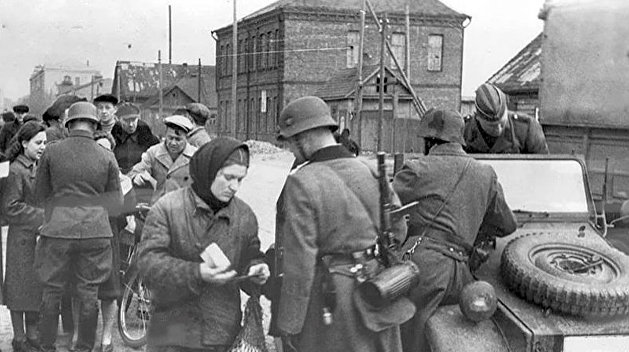The following article by a Ukrainian political analyst and historian in exile Rostislav Ischenko provides a much-needed context for both the current proliferation of Nazism in Ukraine, and the Banderite phenomenon of WWII.
The Great Patriotic War in Ukraine
by Rostislav Ischenko, published 09.05.2020 on the portal Ukraina.ru and at the open blog platform Kont.
It is sometimes said that the war started earlier for Ukraine than for the rest of the USSR. Thinking of the fact that when Hitler attacked Poland, the Western Ukrainian and Western Belorussian lands were part of the latter and thus also came under attack

German checkpoint
This, however, is not entirely true. By the way, this interpretation of events has almost got no traction in Belorussia. And this is logical. The fact is that the German troops attacking Poland did not advance further than the Brest-Lvov line. Serious fighting was only for Lvov over the course of 2 days. After defeating the Polish group that retreated to the city, the Germans abandoned the city, which the Red Army entered, and it, along with all the Western Ukrainian territories, was annexed to the Ukrainian SSR.
If anyone in Ukraine entered the war on September 1, 1939, it was Ukrainian nationalists who opposed the Polish state on the side of Nazi Germany, just as they sided with Hitler against the USSR on June 22, 1941.
This difference between the Western Ukrainian territories and the Ukrainian SSR, the Belorussian SSR, and even the territories of Western Belarus (which were part of Poland before 1939) was well understood by Hitler. The Nazi dictator clearly understood the mentality of the peoples who inhabited the UkSSR much better than his generals and party bonzes. Let’s see how he administratively divided the occupied territories of the USSR.

 This post is a translation of an article by a Ukrainian politolog and historian in exile Rostislav Ischenko. The translation will be supplemented with commentary, references and images added by yours truly. This is an important reading to understand the symbolism and history of St.George ribbon – “Georgievskaja lentochka” in Russian.
This post is a translation of an article by a Ukrainian politolog and historian in exile Rostislav Ischenko. The translation will be supplemented with commentary, references and images added by yours truly. This is an important reading to understand the symbolism and history of St.George ribbon – “Georgievskaja lentochka” in Russian.